Menus
- Triumph’s mid-range enduro endurance test
- Accessories put to the test
- Exhaust recommendation
- Tire recommendation
- Defects in the test
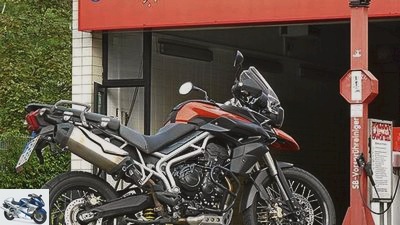
Sdun
Endurance test interim result: Triumph Tiger 800
Triumph’s mid-range enduro endurance test
The Tiger 800 XC celebrated a spectacular debut with victory in the comparison test of mid-range travel enduros. Is the technology still on the cuddle course even after almost 30,000 kilometers??
The Triumph Tiger 800 XC came, it saw and it won. And against the entire establishment of mid-range travel enduros in the large MOTORRAD comparison test (issue 9/2011). Hand on heart, hardly anyone would have expected that from the British debut in this segment. In the end, the little Tiger prevailed with great traveling qualities and, above all, its sleek and highly refined three-cylinder engine. Understandable, after all, its technical basis – the 675 triplet from the Daytona 675 or Street Triple – has long been considered one of the most emotionally charged motorcycle drives. And it is just as understandable that MOTORRAD accompanies the restart of this concept over the endurance test distance of 50,000 kilometers.
MOTORRAD action team employee Uwe Reitmayer was one of the first to run the tigers. After two weeks in Liguria and various Alpine passes, the Swabian, privately on the road on a Honda Transalp, shared the enthusiasm of the test team and summed up his euphoria in the logbook: “My next motorcycle is called the Tiger 800 XC.”
M.eight love blind? No, but forgiving. Because MOTORRAD travel professional Markus Biebricher complains about the luggage system, for example. The original cases are very easy to assemble, but the floating suspension typical of Triumph looks shaky.
Buy complete article
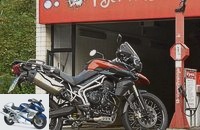
Endurance test interim result: Triumph Tiger 800
Triumph’s mid-range enduro endurance test
Jahn
Triumph Tiger 800 XC Wheelie.
The Englishwoman is relatively insensitive to the choice of tires. Thanks to the narrow dimensions (90 / 90-21 at the front, 150 / 70-17 at the rear), the 800 can handle all of the tires driven in the tire recommendation. On the long-term test bike, both the Bridgestone BW 501/502 and the Pirelli Scorpion Trail achieved 10,000 kilometers each. By the way: the chain is still in astonishingly good shape even after almost 28,000 kilometers.
Probably also a merit of the smooth power development of the three-cylinder. Too much meekness for Thomas Schmieder. “The kick is gone”, the MOTORRAD test editor noted shortly in the logbook. Even if the Triumph technicians consciously instilled in the 800 engine the sovereignty of a travel enduro engine instead of the greedy bite of the 675 engine. Whereby the processing “could be a little more loving”, and not just in Schmieder’s opinion. Even if the British avoided gross blunders, some of the somewhat rustic details (bulging weld seams, protruding suitcase hooks, play on the footrest mountings, jagged knee joints) could be a bit more pleasing.
With which the Tiger pilot can still live well. Because despite the return spring of the selector shaft that broke off shortly before this interim balance sheet, the Englishwoman shows herself to be mechanically problem-free and conceptually mature. Or as MOTORRAD test editor Peter Mayer put it: “With the Tiger to the end of the world? Gladly. ”Even if 22,000 kilometers would initially be enough to end the endurance test.
Accessories put to the test
MPS photo studio
Spring legs for the Triumph Tiger.
Struts
Basically, the tuning of the standard strut of the Triumph Tiger 800 XC has been successful. The exceptionally wide adjustment range of the rebound damping allows the right adjustment for every driving style (setting MOTORCYCLE endurance test machine: 1.5 turns open), the comfort is decent.
The fact that the compression damping cannot be adjusted doesn’t bother much. It is more likely that the spring has to be pre-tensioned to the maximum in the solo setting and thus offers little reserves for two-person operation. MOTORRAD tried three alternatives to the original part from Showa (price: 788 euros).
Wilbers type 625 (Shock absorber: 499 euros, hydraulic spring preload: 199 euros, www.wilbers.de)
No expansion tank, no adjustment of the compression damping – the Wilbers Monoshock shows that a good basic set-up is enough for a proper performance even without many adjusting screws. Especially since the adjustment range of the rebound damping is huge. With a relatively hard, slightly pretensioned spring, the shock absorber is at the standard level in terms of comfort in solo operation, but offers more reserves for higher loads.
Mupo AB2 (Shock absorber: 939 euros, hydraulic spring preload: 219 euros, www.zupin.de)
After very good results in various MOTORRAD endurance testers, the Mupo shock absorber in the Triumph Tiger is not completely convincing. The adjustment range is only moderately wide, the rebound damping is on the soft side and the spring is on the hard side. Good: Both rebound and compression damping can be adjusted using a handwheel without tools. A socket wrench is required to change the spring preload. Similar to the Wilbers shock absorber, the ride comfort of the Mupo shock absorber is at the level of the standard part, but can be adapted much better to passenger operation.
WP Suspension, model 4014 Fusion (Shock absorber: 799 euros, hydraulic spring preload: 229 euros, www.wp-germany.com)
As elegant as the look of the Austrian shock absorber – WP Suspension is part of the KTM group – is so convincing that it was set up. The setting ranges of the fully adjustable (high- and low-speed compression, rebound, spring preload) monoshock are extremely wide and enable precise fine-tuning. Both in solo and pillion mode, the AB2 offers the best comfort of all the shock absorbers tested, and balances the motorcycle well even when used by two people. The only point of criticism: Changes to the damping or spring preload can only be made with a tool instead of a handwheel.
Rear wheel cover
Splashes of chain grease on the rear fairing, pillion passenger grab handles and the inside of the left case? This is due to the Tiger’s standard chain guard, which is a little too short. A self-made, five centimeter long plastic extension keeps the grease away. The rear wheel cover from Pyramid Plastics offers all-round protection. In addition to the shock absorber, which is protected from road dirt, the British manufacturer has also taken into account the aforementioned extension of the chain guard. The perfectly fitting, visually appealing and high-gloss lacquered (but not colored) part costs 149 euros from the importer (www.powerparts-hinz.de).
Brake pads
High hand strength, moderate bite – the somewhat weak front brake is one of the most criticized shortcomings of the Tiger in the logbook. With rubbers from TRW-Lucas (type: MCB 598SV), the double disc system bites a bit more, especially in the low speed range, and is easier to dose due to the lower manual force required. However, the stoppers do not mutate into one-finger brakes when the pads are changed (purchase: www.trwmoto.com, 37.95 euros / pair).
Discs
No question, for drivers around 1.80 meters with the serial plate, shoulders and part of the head are largely in the air flow. The high retrofit disc from Triumph (159 euros) brings improvement. However: The adjustable shield vibrates at higher speeds and, like the series part, could not be able to cope with the load over time. The favorite: Variotouring screen from MRA. Bomb-proof assembly, adjustable with the adjustable attachment, hardly any turbulence, very good wind protection (www.mra.de, 189.80 euros). However, when the steering wheel is fully turned, the handle shell slightly touches the window.
MPS photo studio
Higher handlebars for the tigers.
Handlebars
Smaller drivers in particular feel uncomfortably stretched over the tank by the Tiger’s series handlebars, which are mounted relatively far forward and slightly cranked, while larger pilots complain about an uncomfortable arm position. With the higher Tour Bar from LSL (89.95 euros, www.lsl.eu), which is more angled at the handlebar ends, the sitting position is clearly straightened. The sitting position is more comfortable, but also more inactive due to the less front-wheel-oriented posture. What is clear, however, is the noticeable gain in comfort due to the greater cranking. The freedom of movement of all trains is retained.
Bench
Not that the spacious standard seats are uncomfortable for the driver and pillion, but the more tightly padded gel seats from the Triumph original accessories range (driver: 195 euros, front passenger: 129 euros) effectively prevent even after more than two to three hours of driving Bruises. Good: The gel retrofit seats also match the standard seat cushions individually.
Heated grip
Heated grips are standard equipment in long-term testers. The original Triumph handle warmers fought bravely for 199 euros. The (non-adjustable) heating output ensures that your hands are warm even in frosty conditions, and the large handlebar switch can be easily operated even with thick gloves.
Main stand
Lubricating the chain, assembly work, loading – a main stand makes life with a motorcycle a lot easier. Basically, the stable part from Triumph’s original accessories range for 199 euros does the same. But because the body weight on the boom obviously cannot be used efficiently, the stand requires a lot of muscle fat to jack up.
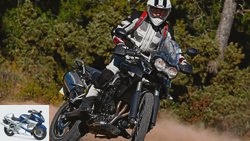
Enduro
Driving report: Triumph Tiger 800 (XC)
Three-cylinder enduro from England
read more
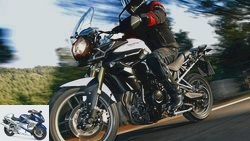
Enduro
Top test: Triumph Tiger 800
The new adventure bike from Triumph in the top test
read more
Exhaust recommendation
MPS photo studio
Mivv Sport Oval Slip On on the Triumph Tiger 800 XC.
Hurric RAC 1
At 269 euros, the Hurric enters the race as a price breaker. So small the price, so small the silencer. Nevertheless, the volume of the RAC 1 remains at the level of the series part. The assembly was not entirely stress-free, and the connecting piece to the intermediate pipe did not fit exactly. The bottom line, however, is a good damper at a fair rate. Price: 269 euros (aluminum), 369 euros (carbon), weight: 3.3 kg, reference: www.fechter.de
Leovince One Slip On Ev02 Carbon
A pithy, powerful bass when accelerating, pronounced babbling when releasing the gas – the Leovince silencer definitely offers the most extraordinary sound experience of the test field. Nevertheless, the Italian retrofit part – like all dampers tested – has an EG-ABE. The attachment is problem-free, but the outer shell slightly touches the Tiger’s case carrier. Price: 339 euros (stainless steel), 449 euros (carbon), weight: 3.0 kg, cover: www.leovince.de
Mivv Sport Oval Slip On
At 2.8 kilograms, the carbon version of the Mivv damper is the flyweight in the test field. At 5.8 kilograms, the series part weighs more than twice as much. Nevertheless, the sound and volume are similar to the original damper. The assembly was a bit fiddly. In addition, when using suitcases, the damper lies against the back of the suitcase. Price: 367 euros (carbon), 379 euros (titanium), weight: 2.8 kg, reference: www.mivv-auspuff.de
Shark Competition DSX-1
Like all retrofit dampers, the Shark DSX-1 gives the Tiger a little more power. What the carbon damper confidently proclaims with a somewhat more robust sound. Since the Shark is screwed to the manifold with the identical intermediate pipe as the Hurric, the not exactly fitting connection and the tension-free assembly also interfered here. Price: 429 euros (carbon), weight: 3.1 kg, reference: www.fechter.de
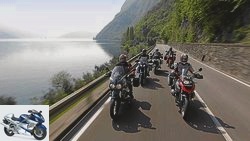
Enduro
Enduros up to 1200 cm³ in comparison
Megatest: travel enduros
read more
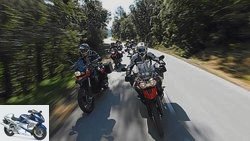
Enduro
Megatest Enduros 2011
The enduro mega test part 1: travel enduros up to 800 cm³
read more
Tire recommendation
MPS photo studio
Bridgestone 501/502 G.
Tires are one of the most underestimated factors influencing a motorcycle’s driving behavior. In addition to the impressions gained with the Tiger 800 XC on the handling course and on the country road, the tire recommendation also included the results from the MOTORRAD enduro tire test in issue 12/2011 (wet grip, wear).
Bridgestone 501/502 G
When cold, the Battle Wing needs some time to instill confidence. Feedback and handling could also be better later. In an inclined position, however, it is extremely stable and extremely neutral. Wet grip: satisfactory; Wear: medium.
Continental TrailAttack
After just a few turns, the Conti TrailAttack create confidence, convince with good grip, agile turning behavior and great maneuverability. Very neutral behavior over the entire lean angle. Wet grip: sufficient; Wear: low.
Dunlop Trailmax TR91
The Dunlop provide good feedback so that the driver quickly dares to tackle large lean angles. There the TR91 show large liability reserves. The handling is very agile. The only drawback: an indifferent steering behavior. Wet grip: very good; Wear: high.
Metzeler Tourance EXP
The Tourance pairing shines with pleasant feedback and good stability up to the limit of adhesion. The turning behavior turned out to be agile, the behavior in an inclined position remains neutral over the entire range. Wet grip: very good; Wear: medium.
Michelin Anakee 2
Appealing handling, good feedback and very good grip even at deep lean angles are the strengths of the Michelin Anakee 2. When driving quickly, however, flexing movements interfere and lead to moderate cornering stability. Wet grip: good; Wear: low.
Pirelli Scorpion Trail
The Pirelli Scorpion Trail behave very neutrally over the entire lean angle. This pairing shows the most stable driving behavior of the test field on deep slopes. However, the handling could be more agile. Wet grip: satisfactory; Wear: high.
Defects in the test
MPS photo studio
The return spring of the selector shaft is broken.
Return spring
The layout was already completed, the texts largely written, when the so far flawlessly running Tiger unexpectedly broke into conversation shortly before the gate closed. Because the British woman suddenly let the gearshift lever hang and could only be moved to gearshifts by gently lifting it. The diagnosis: the return spring of the selector shaft was broken. Fortunately, the broken spring piece was still dangling from a very thin piece of material and therefore did not cause any consequential damage to the engine innards. The repair effort (under warranty) was also limited. After a short time, the Tiger was operational again.
Windshield
After almost 20,000 kilometers, the standard window became a victim of wind forces. The shield, which vibrated strongly at high speed, tore through in the area of the adjusting screw. The part was also replaced on goodwill. Speaking of tearing off: In the tank bag from the Triumph original accessories program, both a plastic eyelet tore off the base plate and the Velcro fastener from the transparent film of the map compartment.

Enduro
Top test: Triumph Tiger 800
The new adventure bike from Triumph in the top test
read more
Related articles
-
Interim balance: Endurance test Kawasaki Z 1000
Gargolov The Kawa-Fighter after 25,000 kilometers interim balance: Endurance test Kawasaki Z 1000 With a heavily revised chassis and above all new …
-
Endurance test final balance Triumph Tiger 800 XC
Bilski 17 pictures mps photo studio 1/17 The Triumph Tiger in the 50000km long-term test. The final balance. mps photo studio 2/17 Typical Tiger: In Tuscany ….
-
Triumph Tiger 1200 XCA in the top test
factstudio.de 21 pictures factstudio.de 1/21 Triumph Tiger 1200 XCA in the top test. factstudio.de 2/21 Despite many buttons, great operating concept. The switches…
-
Endurance test final balance Yamaha XT 660 X
Bilski endurance test final balance of the Yamaha XT 660 X The tent travelers Thirty years after their debut, the youngest generation of the Japanese …
-
Endurance test Triumph Thruxton R
Tobias Wassermann 33 pictures Andreas Bildl 1/33 Done: The 50,000 kilometer distance was completed by the Thruxton R. Michael Schumann 2/33 Collects …
-
Endurance test interim balance: KTM RC8
Endurance test interim balance sheet KTM RC8 Conclusion after 25,000 kilometers No easy task to build the first super sports car in the company’s history, which then …
-
Jahn Top test Triumph Tiger 955i The mild cat Tigers are aggressive, strong and stubborn. Commonly regarded as wild, untamable creatures with a lot of…
-
Top test Triumph Tiger The tiger is loose Now eat away, the tiger. Escape from the cage and tank, the sleek big cat goes on the hunt for long-legged…
-
Jahn 34 photos Jahn 1/34 Jahn 2/34 Lonely: The KTM is the only one of the adventure enduro bikes to stay with the chain drive. Light, but in need of…
-
Endurance test final balance of the Kawasaki ZX-10R
Bilski endurance test final balance sheet Kawasaki ZX-10R Too good to strip After 50,000 kilometers it is opened, looked inside and measured. So are the …